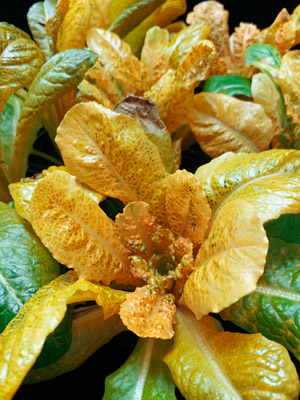Valencia, Spain
September 12, 2024

A research group from the Research Institute for Plant Molecular and Cellular Biology (IBMCP), a joint centre of the Spanish National Research Council (CSIC) and the Universitat Politècnica de València (UPV), has developed an innovative method for the biofortification of leaves and other green plant tissues, increasing their content of healthy substances such as beta-carotene, the main precursor of vitamin A in the human diet.
The work demonstrates that by using biotechnological techniques and treatments with high light intensity, the levels of beta-carotene in leaves can be multiplied up to 30 times by creating new places to store it without affecting vital processes such as photosynthesis. The results are published in the Plant Journal.
Beta-carotene is one of the main carotenoids, pigments found naturally in plants and other photosynthetic organisms that benefit health, with antioxidant, immunostimulant and cognitive-enhancing properties.
Specifically, beta-carotene is the primary precursor of retinoids, chemical compounds with essential bodily functions (vision, cell proliferation and differentiation, immune system...), including vitamin A.
Using tobacco plants (Nicotiana benthamiana) as a laboratory model and lettuce (Lactuca sativa) as a cultivation model, the team led by Manuel Rodríguez Concepción, CSIC researcher at the IBMCP, has managed to increase the beta-carotene content in the leaves without negatively affecting other vital processes such as photosynthesis.
'Leaves need carotenoids such as beta-carotene in the photosynthetic complexes of chloroplasts for their proper functioning,' explains the CSIC researcher. 'When too much or too little beta-carotene is produced in the chloroplasts, they stop functioning, and the leaves eventually die. Our work has successfully produced and accumulated beta-carotene in cellular compartments where it is not normally found by combining biotechnological techniques and treatments with high light intensity,' he summarises.
Higher accumulation and bioaccessibility
The results of this study, published in the Plant Journal, show that it is possible to multiply beta-carotene levels in leaves by creating new places to store them outside the photosynthetic complexes. On the one hand, they have managed to store high levels of beta-carotene in plastoglobules, and fat storage vesicles are naturally present inside chloroplasts. These vesicles do not participate in photosynthesis and do not usually accumulate carotenoids.
‘Stimulating the formation and development of plastoglobules with molecular techniques and intense light treatments not only increases the accumulation of beta-carotene but also its bioaccessibility, i.e. the ease with which it can be extracted from the food matrix to be absorbed by our digestive system,’ says Luca Morelli, first author of the study.
Biofortification of vegetables
The study also shows that beta-carotene synthesis in plastoglobules can be combined with its production outside chloroplasts by means of biotechnological approaches. In this case, co-author Pablo Pérez Colao says, 'beta-carotene accumulates in vesicles similar to plastoglobules but located in the cytosol, the aqueous substance that surrounds the organelles and nucleus of cells’.
The combination of both strategies achieved up to a 30-fold increase in accessible beta-carotene levels compared to untreated leaves. The massive accumulation of beta-carotene also gave the lettuce leaves a characteristic golden colour.
According to the researchers, the discovery that beta-carotene can be produced and stored at very high levels and in a more bioaccessible form outside the places where it is usually found in leaves 'represents a very significant advance for improving nutrition through biofortification of vegetables such as lettuce, chard or spinach without giving up their characteristic scent and flavour'.
Reference:
Morelli L, Perez-Colao P, Reig-Lopez D, Di X, Llorente B, Rodriguez-Concepcion M. Boosting pro-vitamin A content and bioaccessibility in leaves by combining engineered biosynthesis and storage pathways with high-light treatments. Plant J. 2024. DOI: https://doi.org/10.1111/tpj.16964
Further information
News UPV TV